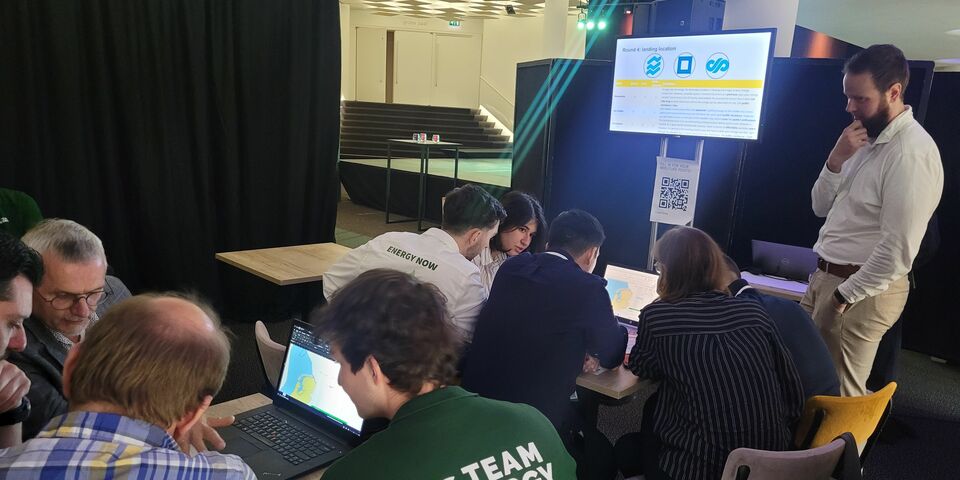Students brainstorm about energy island in the North Sea
The seventh edition of Energy Now, Team Energy’s annual inspiration and networking event revolving around sustainable energy, took place at the Muziekgebouw last Wednesday. Companies were present to try and recruit young talent and those attending took part in various workshops, for example on designing a wind energy hub in the North Sea.
Energy Now focuses on developments in the area of sustainable energy, but covers a lot more than the technological topics that are typically featured, such as energy production and storage, says Promotion Lead of Team Energy Juliana Boschero. Companies that participate are also working on the current grid congestion problems, the business side of things (including the efficient handling of supply and demand on the energy market), energy neutrality in cities and neighborhoods, sustainable fuels, etc. “That’s why the event is interesting for a wide range of students enrolled in all kinds of programs,” says Boschero.
Having a direct impact
About two hundred people – administrators, entrepreneurs, and civil servants in addition to students – have come together at the Muziekgebouw in Eindhoven this Wednesday morning, for the largest energy conference in the Brainport region. The program consists of lectures and keynote speeches covering various aspects of the energy transition – from the latest technological developments to funding.
Every year, Energy Now also gives students the opportunity of talking to companies that interest them during the networking part. Dozens of organizations, including EIRES, Tibo Energy, Carbyon and Equans, are trying to get the young talent excited about internships, traineeships, side jobs, or future careers. This also goes for energy supplier Essent. “Back when I was a student myself, Energy Now didn’t exist,” says Erik Andela, TU/e alumnus of Mechanical Engineering and Design Engineer Renewable Energy Systems at Essent. “I think it's a good way for students to see what’s out there.”
A bit further along, Floor Hulshof is smiling behind the stand of EnergieStudent, a foundation that matches students to companies that are active in the energy transition domain. “Many students want to contribute to the energy transition, but don’t really know how,” says the student of Global Sustainability Science at Utrecht University. “As a mediator, we help students get assignments in the energy sector that allow them to have a direct impact. This is how we’re trying to bridge the gap between students and business.”
Offshore wind energy
During the workshop part, those attending – mostly students – get to work on an assignment from practice. Grid administrator TenneT, for example, presents an interesting case study: the North Sea Wind Power Hub (see main photo). This program sees a consortium of Dutch, Danish and German partners working on realizing a sustainable energy island in the North Sea. The aim is to generate offshore wind energy and transport it to the mainland using cables in the ocean floor, all geared towards contributing to the energy transition.
First, the participants get an explanation about this ambitious project that’s scheduled for completion around 2050. They then split up into groups to discuss how to approach the construction of an energy hub. In so doing, they have to keep three important criteria in mind: money (it shouldn’t be too expensive), time (the deadline must be met), and resilience (the risk of safety incidents must be as low as possible).
They must first decide on which location in the sea they intend to construct the energy hub, after hearing about the specific pros and cons of each of them. The same goes for the three landing points they can choose from (the Maasvlakte, Den Helder or Eemshaven) and the type of substructure (a caisson, a platform, or a ‘gravity-based structure’).
Risk assessment
Finally, a roll of the dice determines which of the six disaster scenarios they will have to deal with. These include a fire, a virus outbreak, and a sudden increase of steel prices. Based on previously made choices, points are deducted from the teams. If they, for example, opted for a construction requiring a lot of steel, they’re out of luck in case the steel prices suddenly go up.
“It’s easy to come up with all kinds of great solutions in theory, but it’s these unforeseen events that can change everything,” says Jelle van Uden, who teaches the workshop on behalf of TenneT. “That means you have to be prepared for those and that’s exactly what this assignment is meant to convey to the participants.” After the team with the highest number of points has won and received applause, Van Uden uses newspaper headlines to demonstrate that all of those disaster scenarios actually happened – from the COVID pandemic to the war in Ukraine that drove up steel prices.
Fun activity
“I thought it was a fun activity,” says Teodora Leolea, a student of Electrical Engineering at TU/e, after the workshop. “We’ve taken various courses on energy transmission, so in that respect, it dovetailed with our program,” says fellow student Ray Langemeijer. “But it was also a bit different because it was about risk assessment. That’s not something we do very often,” Leolea adds.
“At first I thought that the different scenarios were simply made up, but then we found out that they actually happened and learnt about their impact, so that was interesting,” says Langemeijer. “This workshop was an interactive way of learning more about this.” Having said that, the students aren’t convinced they want to join TenneT to contribute to the project itself. “I’m not sure yet what I want to do after my studies,” says Leolea. “I think I’ll go into another direction,” says Langemeijer.


Discussion